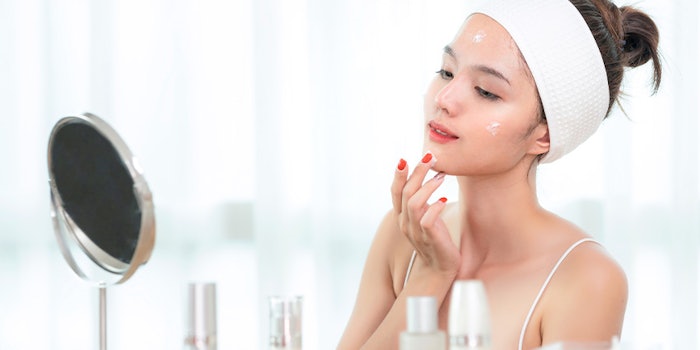
A study¹ in the 1990s found that the application of probiotics in a skin care product improved the immunity of the skin by generating antimicrobial peptides and eradicating pathogens. More recently, the Skinwiser company examined the effects of probiotics on the skin². The study looked at which bacterial strains were more useful for which skin conditions. In general, the results show that topical application of certain probiotics made skin healthier and improved skin conditions, including acne.
Before we delve further, it’s important to define our terms:
- Probiotics: any living, good bacteria that help maintain body health
- Prebiotics: any nonliving food components that encourage the growth of probiotics
- Postbiotics: soluble factors (metabolites) produced as result of probiotic fermentation of prebiotics
It must be noted that the following are not probiotics because they do not contain any live bacteria:
- Products containing ferments (foods such as brewer’s yeast and wine are the results of fermentation)
- Products containing extracts (concentrated forms of active substances from flowers, fruits and mushrooms)
- Products containing lysates (material formed by the breaking down of cell membranes through enzymatic, osmotic, or viral mechanisms)
Live Bacteria in Skin Care & Personal Care: Buyer Beware
Probiotics do have documented skin benefits, but these live cells have not been commercially used in skin care and personal care products. This new frontier of adding live bacteria in skin care and personal care products is a challenge for manufacturers because, traditionally, the presence of bacteria in these products is associated with contamination. Some manufacturers are worried about materials (ingredients) that contain bacteria—either alive or deactivated. They are concerned about two main issues: Regulations regarding bacterial contamination of skin care and personal products, and the complications of preserving creams and lotions while keeping good bacteria alive.
These concerns are indeed valid. At the moment, the European Union regulations don’t allow for the intentional addition of bacteria to skin care and personal care products. If beneficial bacteria are indeed added, the hurdle is how to preserve the product so it won’t become unstable and spoil.
Guidelines on preservatives need to progress so that good, live bacteria are differentiated from bad, live bacteria. At the moment, however, this is new territory, and manufacturers should take the precautionary approach, given the legal implications.
Consumers should take precautions, too. Checking the labels may not be enough. Shoppers may need to investigate further before deciding to buy. One of the best strategies is buying skin care and personal care products from companies that have a philosophy of transparency, so consumers can be reasonably sure that their products are what they say they are, and do what they promise.
Unfortunately, many skin care and personal care products advertised as containing live probiotics are, in fact, mislabelled.
How Prebiotics Work in Skin Care and Personal Care Products
A 2017 study found that direct application of prebiotics on the skin enhanced the activity and growth of good skinisms³, which is a group of microorganisms (bacteria, virus or fungus) that live on the skin. When prebiotics are added to skin care and personal care products, they directly increase the activity and growth of healthy, good skinisms and limit the growth of unwanted bacteria. Although little is known about the efficacy of topically applied prebiotics, Nashville-based Cosmetic Research Lab has been seeing positive results using patented prebiotic technology in the treatment of acne.
Preliminary unpublished and non-peer-reviewed studies have recently demonstrated that specific prebiotics were 99.9% effective at suppressing two acne-causing bacteria within 30 seconds of application. This vetted research was carried out by a third party laboratory Micro Quality Labs, based on microbiological tests on the two acne causing strains: P.acnes and Staph aureus. More studies are underway, but this does highlight the positive effect on skin by regulating the immune system and providing therapeutic benefits for inflammatory skin diseases, as detailed in the 1996 H. Christian et al. research.
How Postbiotics Work in Skin Care & Personal Care
The challenge of including postbiotics in skin care and personal care products is that the science is very much in its early stages because postbiotics’ role in human health has only recently been studied. Nonetheless, Postbiotica (an adjunct of the University of Milan) claims that postbiotics may have many advantages⁴.
Postbiotics ingredients are not harmful. They contain higher amounts of active components and can be used at lower levels without affecting their performance⁵.
Without knowing it, many people and brands have been using skin care and personal care products with active ingredients that naturally boost postbiotic levels, including:
- Algae, chlorella and spirulina
- Aloe (fermented)
- Apple cider vinegar
- Brewer’s yeast enzymes
- Coconut vinegar
- Grape pomace
- Humic, fulvic, and lactic acids
- Shilajit (ancient, thick, tar-like substance found in the rocks of the Himalayas and Caucasus Mountains)
Based on these facts, I am sure it will not be long before we start to see postbiotics intentionally added to skin care and personal care products.
More Research, Future Innovation
Researchers, the beauty industry and conscious consumers are all coming to the same conclusion: the skin microbiome is an exciting new field of study that may offer safe and effective treatment options to those wanting healthier, more youthful-looking skin, and those suffering with challenging dermatological conditions.
Further research is needed to study the effects of skinisms and how skin care and personal care products can restore bacterial diversity and balance. Above all else, safety must be a top priority.
Until then, however, there are many proactive steps consumers can take now to prevent skin issues and help reverse any that have already happened. It appears that one of the main weapons in the defence against bad bacteria is to have the most diverse and balanced skin microbiome possible—in other words, happy and healthy skinisms.
References
(1) Christian H, et al. The effect of detergents on skin pH and its consequences. Clinics in Dermatology. 1996 Jan/Feb; 14(1):23-27
(2) Schmid-Wendtner MH Korting HC. The pH of the skin surface and its impact on the barrier function. Skin Pharmacol Physiol. 2006; 19(6): 296-302
(3) Dreno B. Skin microbiome and acne vulgaris: Staphylococcus, a new actor in acne. Exp Dermatol. 2017 Sep; 26(9): 798-803
(4) Nakatsuji T, et al. Antimicrobials from human skin commensal bacteria protect against Staphylococcus aureus and are deficient in atopic dermatitis. Sci Transl Med. 2017 Feb 22; 9(378)
(5) Aguilar-Toalá, J.E., García-Varela, R., García, H.S., Mata-Haro, V., González- Córdova, A.F., Vallejo-Cordoba, B., Hernández-Mendoza, A., Postbiotics: An evolving term within the functional foods field, Trends in Food Science & Technology (2018), doi: 10.1016/j.tifs.2018.03.009.










